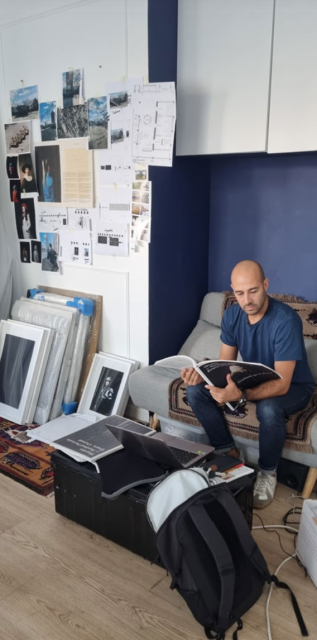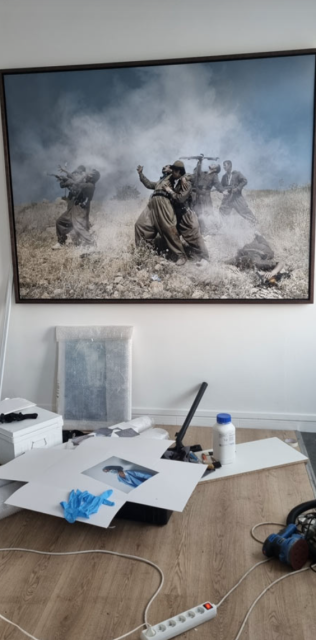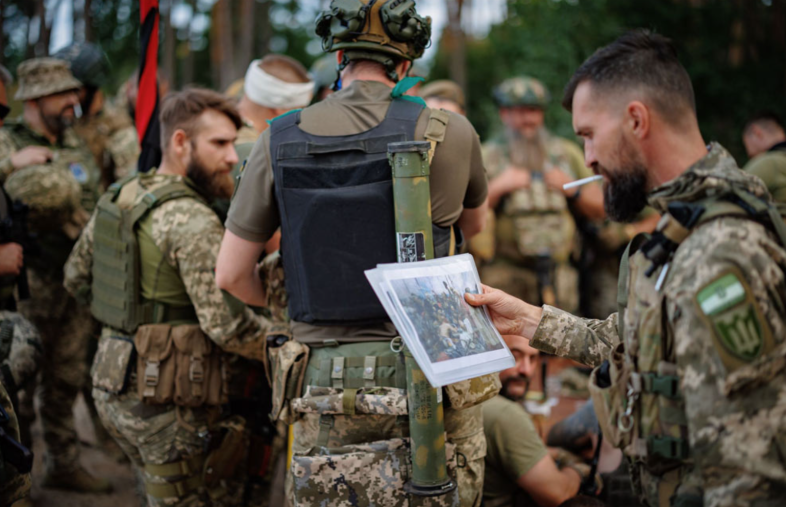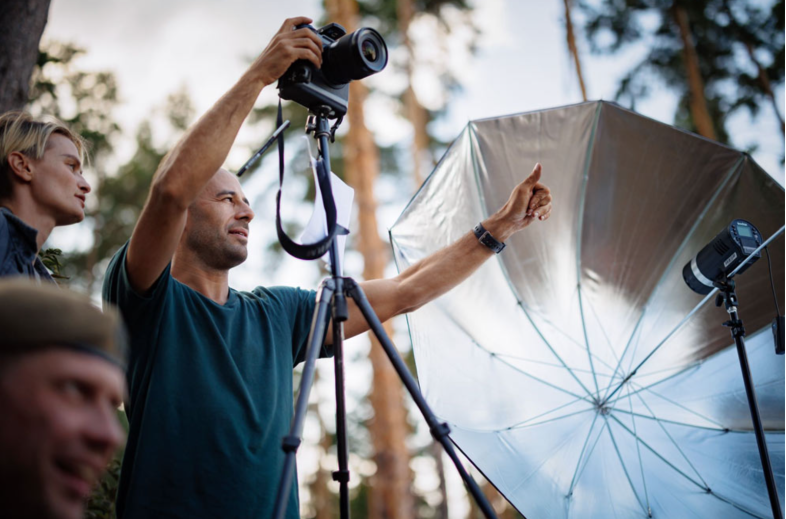This photo, created by the French photographer Émeric Lhuisset, went viral on social media. It is a creative reinterpretation of Repin’s painting “Zaporizhzhian Cossacks Writing a Letter to the Turkish Sultan”.

Photo: Maryna Kumeda
Émeric Lhuisset first visited Ukraine in 2014. Initially, he followed the events of the Maidan from Paris, but then the first casualties made it clear that something serious was happening. He decided to go to Kyiv; he took 100 portraits of people involved in the Revolution of Dignity as a tribute to the Heavenly Hundred, the 107 people who were killed by the Berkut police during the revolution. These portraits were compiled into a book titled “André Frère Editions and Paradox (Ydoc) Maydan — Hundred Portraits (2014)“. Before arriving in Ukraine, Émeric Lhuisset spent many years travelling through the Middle East. For over 20 years, he travelled to places where wars were happening, and history was being made; in a way, he had been conducting anthropological research and translating the results into art.
Émeric grew up in the French city of Esson in northern France. At the age of 40, he still remembers the umbrella stand shaped like a shell casing left by his great-grandfather, a colonel who fought in both world wars. He also recalls his grandmother’s words at dinner when he refused to eat soup: “If you knew war…”. It was then, looking through history and geography textbooks, that he first encountered artworks depicting war: a tapestry from Bayeux, engravings by Otto Dix, Picasso’s Guernica. As a teenager, Émeric realised that his grandmother’s school textbook from the 1930s did not match the history in his own school textbook.
Émeric Lhuisset graduated from the School of Fine Arts in Paris; he studied geopolitics at the École Normale Supérieure and the Sorbonne. In 2002, for the first time, he travelled to a warzone: first to Afghanistan, then to Iraq, Lebanon, and later, in 2012, to Syria. He adapted to the environment and appeared to have blended in with the local residents. A Japanese photojournalist photographed him with Syrian fighters, unable to tell the difference.
At the same time, Émeric conducted scientific research at the ACTE Institute at the University of Paris 1 Panthéon-Sorbonne, focusing on the evolution of the visual representation of war. In his opinion, several events significantly changed the context: firstly, the advent of Kodak film, which democratised image production, and the publication of photographs in the press, starting in the late 19th century. The next turning point was photojournalism of the 1930s, Robert Capa’s character created by Gerda Taro and Endre Friedmann, and more recently, the September 11 attacks in the United States, which led to a flood of amateur photos freely available. It was then that the media lost their monopoly on images. The widespread use of smartphones during the Arab Spring was another revolution. Its symbol is the iconic photo of Gaddafi on the screen of a mobile phone held by one of the fighters in the group that captured the dictator. And finally, the full-scale Russian invasion of Ukraine.
Photographs of crowds in the streets attempting to block Russian armoured vehicles, a man kneeling in front of a Russian tank, demonstrations held by the local residents of occupied cities, or even photos of Azovstal taken by amateurs, as well as a majority of the images from the front line— all these photos were taken by non-professional photographers. The awareness of these changes prompts Émeric to question the role and place of professional photographers in war, as anyone can take a photo at any time and instantly share it on social media.

Photo: Maryna Kumeda
“This does not mean that the work of professionals during wartime is no longer needed; perhaps it requires a different form”, said Émeric in a manifesto for the exhibition titled “Seeing War and Achieving Peace” at the Pompidou Center. “It’s not about finding an event to capture, but about a post-documentary approach. It involves exploring the image format, the local context, and the history of the image through a more conceptual analysis. Perhaps a perspective and narrative of the event’s main protagonist should be at the centre of this process.”
In his work, Émeric dedicates a lot of time to understanding the context and discussing his projects with local participants in the events. A Lebanese gallery became his first agent, and his works were exhibited in Iraq, Syria, Bosnia, Colombia, Cambodia, China, Brazil, Germany, Spain, Italy, England, the United States, and the Netherlands. The photo “I Heard the First Ring of My Death,” taken in 2010–2011, is part of the collection of the Stedelijk Museum in Amsterdam.
Émeric returned to Ukraine in early March 2022. He photographed volunteers from behind to protect their identity in case of a potential Russian occupation (the book “Ukraine — Hundred Hidden Faces” was published in France). He was asking them the same two questions asked in 2014: “What would you like to happen now? What do you think will happen?”. “War,” one of the girls answers to the second question, initially explaining that she would like to return to university “as soon as possible”. Upon his return to France, Émeric organised a video conference between his French and German students and Ukrainian volunteers during the contemporary art and geopolitics lectures he teaches at the Institute of Political Studies. “They are just like us,” his students said later. They have stayed in touch with their Ukrainian colleagues since.
According to Émeric, visuals hold significant importance in Ukrainian culture, from the ancient icon painting tradition to the fervent documentation of war, as well as the social and human changes it brought, and to the culture of selfies.
It was during the Maidan protests that Émeric Lhuisset first came across a reproduction of the famous painting by Ilya Repin, which was held by demonstrators. As a farewell gift, one of his Ukrainian friends gave him a refrigerator magnet featuring this iconic work.

Photo: Oleh Palchyk
Later, in February 2022, when he heard the Snake Island Ukrainian defenders’ response to the crew of the Russian flagship ‘Moscow,’ the artist immediately remembered Repin’s painting. In June 2022, he undertook a project to reproduce the painting. It took a year of preparation for it to come to life. Émeric gathered 40 fighters from the 112th brigade; staging took an entire day. The photograph was taken at 17:14 on Friday, 1 September, near Kyiv, on the slopes of the Dnipro river.
The photo quickly spread on Ukrainian social networks. In the commentary to it, the author explained: “Russia has appropriated a significant part of Ukrainian history. As evidence, I cite a 50,000-character text written in July 2021 by Vladimir Putin. He explains that Ukraine is an artificial formation, and its history is actually Russian. He will use this text in a few months to justify his invasion”.
Today, Émeric Lhuisset emphasises the need to revise the ‘colonial’ discourse in France, especially, at the institutional level. For example, the first retrospective of Ilya Repin at the Petit Palais in 2021 under the title ‘Painting the Russian Soul’ presents the artist as the “most significant Russian painter of the 19th century”. However, Repin was Ukrainian, spoke Ukrainian, and depicted not only the so-called ‘Russian soul’ but also Ukrainian personalities, events, and landscapes. He also carefully selected the characters for this painting: almost all of them were Ukrainians, except for one Pole, and one Crimean Tatar. According to some historians, this symbolised the Russian oppression experienced by these represented nations.

Photo: Oleh Palchyk

